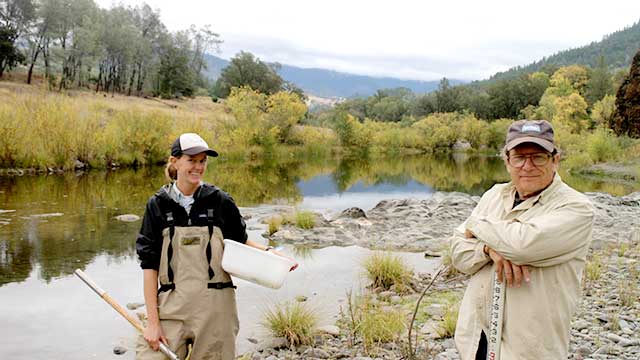
Along the upper part of the river sits the Potter Valley Project, a massive power-generating facility that consists of two dams and a tunnel that diverts water to the East Fork of the Russian River.
The project has become controversial in recent decades due to its serious impact on the river’s salmon populations. Advocacy groups and others have called for the dams to be removed.
Now, as the government prepares to consider relicensing the project, Humboldt State Environmental Science & Management professors Alison O’Dowd, William Trush, and James Graham, along with several undergraduate and graduate students are working to get a better understanding of how the dams affect the salmon.
“Salmon are not only charismatic species but they’re indicative of watershed health. So if the salmon aren’t doing well then the amphibians, invertebrates and other aquatic organisms probably aren’t doing well either,” says O’Dowd.
The plummeting population of Eel River salmonids (coho and Chinook salmon, and steelhead trout) over the last several decades paints a grim picture. Before 1900, there were an estimated 500,000 salmonids (70,000 coho, 175,000 Chinook and 255,000 steelhead) in the Eel River watershed, according to the National Marine Fisheries and Service (NMFS).
Today, there are fewer than 15,000 salmonids—a 97 percent drop in population that environmentalists have partially attributed to the Potter Valley Project owned by PG&E.
Starting in the mid-1800s, hundreds of dams were built along California’s rivers. The Potter Valley Project began in 1908 with the completion of the Cape Horn dam, and it has been diverting water to the Potter Valley in the Russian River watershed ever since. Scott Dam was completed in 1922 and that year, the Federal Energy Regulatory Commission granted the project a 50-year license.
Over the next decade, the Commission will review licenses for about 150 dams, including Scott Dam, which is set to expire in 2022.
In the meantime, local environmental advocacy group Friends of the Eel River, which has been fighting for the removal of the dams for the last 20 years, has turned to O’Dowd and Trush to study blockwater releases.
The impetus for this research, conducted through HSU’s River Institute, was the plight of the salmon that lingered between the two dams. Under natural conditions, rising water temperatures and lower flows are Mother Nature’s signals for juvenile salmon to begin migrating out to the ocean.
However, fish rearing in the artificially cool and consistently flowing waters between the dams lingered into the summer months so that by the time they left, they swam into water with lethally high temperatures and lower flow conditions.
To push the fish downstream and help their outmigration, PG&E conducted blockwater dam releases in 2012, 2014 and this past spring. Releases are at the discretion of the NMFS and the California Department of Fish and Wildlife, while the timing and volume of each release are based on a NMFS recommendation. However, O’Dowd and Trush hope to pinpoint exactly when, how much, and for how long water should be released to help the fish thrive.
They’ll do this by examining what the Eel River ecosystem looked like before the dams were built, and recommending ways to mimic the natural flow at times when the fish are most vulnerable.
Another aspect of their research will examine how much salmonid habitat exists in the watershed upstream of the impassable Scott Dam. To find the answer, O’Dowd and Graham (with support from California Trout) will use GIS modeling and field data to find spawning areas, rearing pools for juveniles, and any migration barriers. This information will be used to create a habitat map that shows what stream areas area accessible for which fish species.
“In a relicensing process when all the pros and cons are weighed, quantifying the amount of salmonid habitat upstream of Scott Dam can help bolster the argument for the modification or removal of the dams,” says O’Dowd. “On the other hand, our results may find that there isn’t much salmonid habitat in the upper watershed critical for their recovery. That’s why we’re doing the science—to see how we can best help the recovery of these threatened fish species.”
Related Links: Map: Eel River (Eelriver.org) | Map: California Dams (KQED) | The Power of Potter Valley (Ukiah Daily Journal) | History of Hydropower (Dept. of Energy) | West Coast Salmon & Steelhead Listing (NOAA)